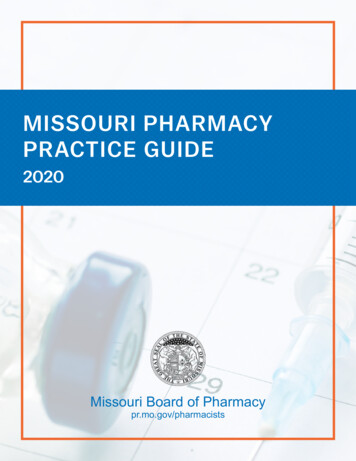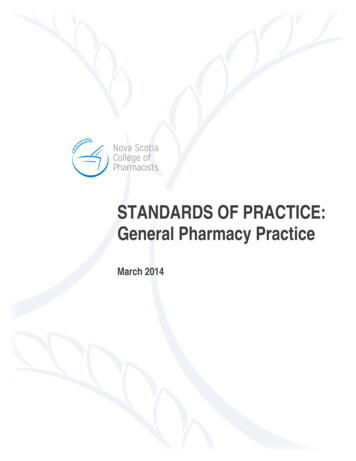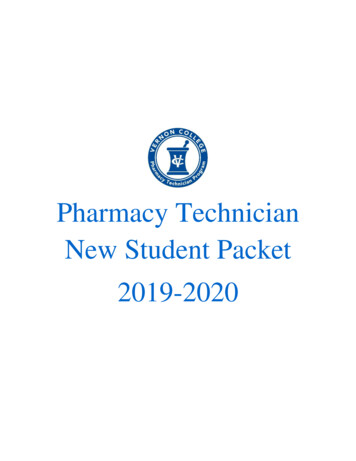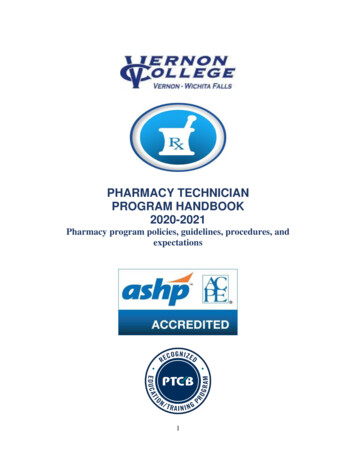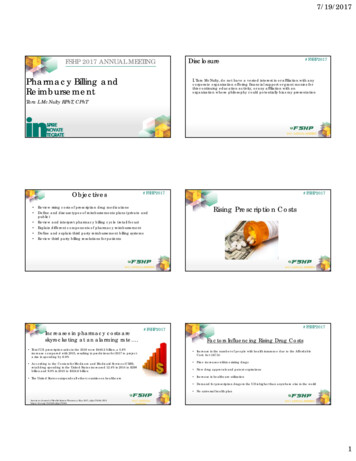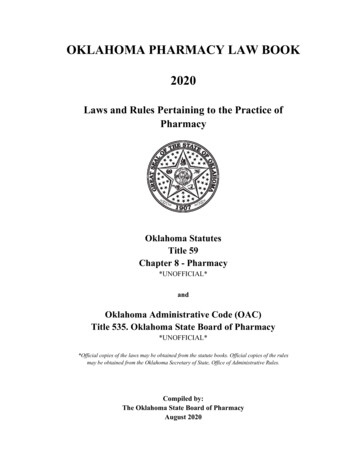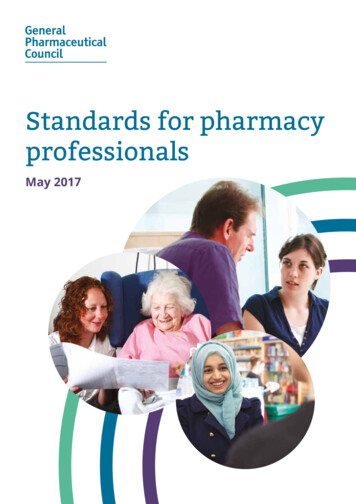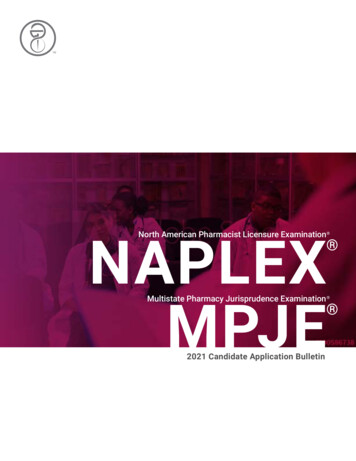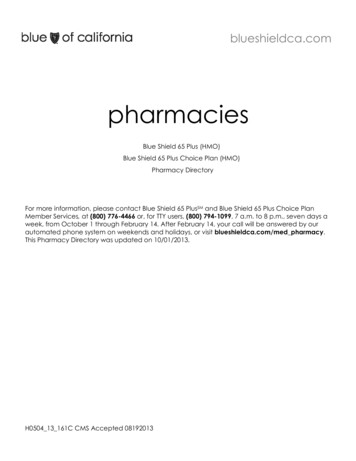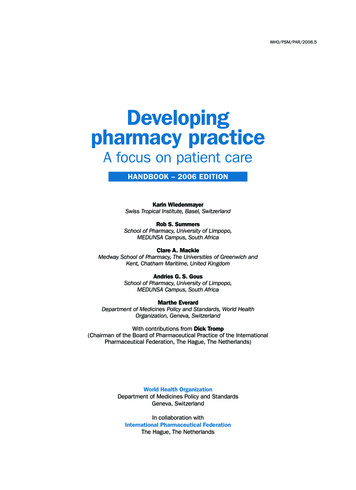
Transcription
WHO/PSM/PAR/2006.5Developingpharmacy practiceA focus on patient careHANDBOOK – 2006 EDITIONKarin WiedenmayerSwiss Tropical Institute, Basel, SwitzerlandRob S. SummersSchool of Pharmacy, University of Limpopo,MEDUNSA Campus, South AfricaClare A. MackieMedway School of Pharmacy, The Universities of Greenwich andKent, Chatham Maritime, United KingdomAndries G. S. GousSchool of Pharmacy, University of Limpopo,MEDUNSA Campus, South AfricaMarthe EverardDepartment of Medicines Policy and Standards, World HealthOrganization, Geneva, SwitzerlandWith contributions from Dick Tromp(Chairman of the Board of Pharmaceutical Practice of the InternationalPharmaceutical Federation, The Hague, The Netherlands)World Health OrganizationDepartment of Medicines Policy and StandardsGeneva, SwitzerlandIn collaboration withInternational Pharmaceutical FederationThe Hague, The Netherlands
World Health Organization and International Pharmaceutical Federation 2006All rights reserved.The designation employed and the presentation of the material in this report including tables and maps, do not imply theexpression of any opinion whatsoever on the part of the World Health Organization and the International PharmaceuticalFederation concerning the legal status of any country, territory, city or area or of authorities or concerning the delimitationof its frontiers or boundaries. Dotted lines on maps represent border lines for which there may not yet be full agreement.The mention of specific companies or suppliers or of certain manufacturers’ products does not imply that they areendorsed or recommended by the World Health Organization and the International Pharmaceutical Federation in preferenceto others of a similar nature that are not mentioned. Errors and omissions excepted, the names of proprietary products aredistinguished by initial capital letters.The World Health Organization and the International Pharmaceutical Federation do not warrant that the information contained in this publication is complete and correct and shall not be liable for any damages incurred as a results of its use.The views expressed in documents by named authors are solely the responsibility of those authors.Cover design by Quim MartellDesigned by minimum graphicsPrinted in The Netherlands
DEVELOPING PHARMACY PRACTICE – A FOCUS ON PATIENT onixPart I. Pharmacists in the health care team: a policy perspective11 New paradigm for pharmacy practice31.1Introduction31.2Main learning objectives51.3What is health?51.4The pharmacy profession51.5New dimensions of pharmacy practice71.5.1Pharmaceutical care71.5.2Evidence-based pharmacy81.5.3Meeting patients’ needs81.5.4Chronic patient care – HIV/AIDS81.5.5Self-medication101.5.6Quality assurance of pharmaceutical care services101.5.7Clinical pharmacy111.5.8Pharmacovigilance121.61.71.81.9The value of professional pharmacist services121.6.113The Pharmacy Practice Activity ClassificationThe pharmacist as a member of the health care team141.7.1Pharmacy practice settings141.7.2Levels of practice and decision-making151.7.3The “seven-star” pharmacist15Pharmacy practice: a commitment to implement change171.8.1Policy changes171.8.2A change in pharmacy education and a new learning approach19Summary191.10 Further reading20Part II. Pharmacists in patient care: a practice perspective232Pharmaceutical care252.1Introduction252.2Main learning objectives262.3The pharmaceutical care process27iii
DEVELOPING PHARMACY PRACTICE – A FOCUS ON PATIENT CARE2.4Pharmaceutical services342.5Referral342.6Summary382.7Further reading383 Information Management and the Use of Evidence403.1Introduction403.2Main learning objective413.3Continuing professional development and life-long learning413.4Critical appraisal in pharmacy practice433.4.1Sources of medicines information433.4.2How to retrieve (and evaluate) medicines information online463.4.3How to obtain relevant information from a pharmaceuticalrepresentative47How to evaluate the medical literature483.4.43.5Pharmacoeconomic analysis563.6Using evidence to develop Standard Treatment Guidelines and anEssential Medicines List593.7Limitations of and misperceptions about evidence-based practice613.8The patient’s viewpoint613.9Summary643.10 Further reading65Glossary67Appendices73Appendix 1: Systematic review (Wilkinson D et al.)75Appendix 2: Example of pharmacoeconomic analysis: Thrombolytics for acute myocardialinfarction (a hypothetical exercise)83Appendix 3: Answers to self-assessment questions, exercises and learning activities85iv
DEVELOPING PHARMACY PRACTICE – A FOCUS ON PATIENT CAREAcknowledgementsThe authors are grateful to the following persons who reviewed previous drafts of this document. Their comments were invaluable.Ms Christal Albert, Cologne, GermanyDr Rosario d’Alessio, WHO/PAHO, Washington DC, USAMs Teresa Alves, FIP Secretariat, The Hague, The NetherlandsDr Douglas Ball, Department of Pharmacy Practice, Faculty of Pharmacy, Health SciencesCenter, University of Kuwait, KuwaitDr Shalom ‘Charlie’ Benrimoj, Assistant Pro-Vice-Chancellor (Health Sciences), Universityof Sydney, AustraliaDr Jan-Olof Brånstad, SwedenDr Perla M. De Buschiazzo, Pharmacology Department, School of Medicine, NationalUniversity of La Plata, La Plata, ArgentinaDr Mhina Chambuso, School of Pharmacy, Muhimbili University College of Health Sciences(MUCHS), The University of Dar es Salaam, United Republic of TanzaniaDr Greg Duncan, Department of Pharmacy Practice, Monash University, Parkville, AustraliaMs Sonia Mota Faria, International Pharmaceutical Students’ Federation, PortugalMs Bente Frokjaer, Vice President of FIP, DenmarkProfessor William Futter, Division of Pharmacy Practice, Rhodes University, Grahamstown,South AfricaProfessor Abdul Ghani, Directorate of Drugs Administration, Ministry of Health and FamilyWelfare, Dhaka, BangladeshMs Ida Gustafsen, EUROPharm Forum, Copenhagen, DenmarkProfessor Ebba Holme Hansen, The Danish University of Pharmaceutical Science,Copenhagen, DenmarkProfessor Abraham Hartezema, Perry A. Foote Eminent Scholar, Chair in Health Outcomesand Pharmacoeconomics, College of Pharmacy, University of Florida, Gainesville, USADr Kurt Hersberger, Pharmaceutical Care Research Group, University of Basel, Basel,SwitzerlandMr Ton Hoek, General Secretary and Chief Executice Officer of FIP, The Hague,The NetherlandsDr Ross Holland, Bowie MD, USADr Adriana Mitsue Ivama, Pan American Health Organization/WHO, BrazilDr Nelly Marin Jaramillo, Pan American Health Organization/WHO, BrazilDr Richard Thuo Kamau, Nairobi, KenyaMr Balkrishna Khakurel, WHO, Kathmandu, NepalDr Rosalyn King, Howard University Continuing Education, Silver Spring MD, USAMs Mirjam Kokenberg, Quality Institute for Pharmaceutical Care, Kampen,The NetherlandsDr Hlonelikhaya Masiza, South Africa Pharmacy Council, Pretoria, South Africav
DEVELOPING PHARMACY PRACTICE – A FOCUS ON PATIENT CAREMs Lindsay McClure, Pharmaceutical Services Negotiating Committee, Aylesbury, UKProfessor Guru Prasad Mohanta, Division of Pharmacy Practice, Department of Pharmacy,Annamalai University, Annamalai Nagar, Tamil Nadu, IndiaDr B.G. Nagavi, JSS College of Pharmacy, Karnataka, IndiaProfessor Lars Nilsson, SwedenDr Christine Nimmo, Bowie MD, USADr Atieno Ojoo, Gertrude’s Children’s Hospital, Nairobi, KenyaDr José Maria Parisi, Pan American Health Organization, Washington D.C., USADr Rose Marie Parr, Scottish Centre for Post Qualification Pharmaceutical Education,University of Strathclyde, Glasgow, Scotland, UKDr Susan Putter, South Africa Pharmacy Council, Pretoria, South AfricaProfessor Ralph Raasch, Associate Professor of Pharmacy and Clinical AssociateProfessor of Medicine, UNC School of Pharmacy, Chapel Hill, USADr Feroza Sircar-Ramsewak, College of Pharmacy, Nova Southeastern University, PalmBeach Gardens, USAMr Howard Rice, Vice President of FIP, IsraelDr Philip Schneider, The Ohio State University, Columbus, USAMr Karl Friedrich Steinhausen, Berlin, GermanyMs Linda Stone, Vice President of FIP, London, UKProfessor Linda Strand, Department of Pharmaceutical Care & Health Systems,College of Pharmacy, University of Minnesota, Minneapolis, USADr Nippe Strandqvist, Honorary President of FIP, SwedenDr Sri Suryawati, Faculty of Medicine, Gadjah Mada University, Yogyakarta, IndonesiaMs Satu Tainio, FIP Secretariat, The Hague, The NetherlandsMs Karin Timmermans, WHO, Jakarta, IndonesiaDr Birna Trap, Euro Health Group, Soborg, DenmarkMr Frans van der Vaart, Scientific Institute of the Dutch Pharmacists and President of theLaboratories and Medicines Control Services Section of FIP, The Hague, TheNetherlandsMs Agathe Wehrli, Secretary of Pharmacy Information Section, FIP, SwitzerlandDr Albert Wertheimer, Center for Pharmaceutical Health Services Research, School ofPharmacy, Temple University, Philadelphia, USA, and President of the AdministrativePharmacy Section of FIPDr Clive Ondari, WHO, Geneva, SwitzerlandDr Hans Hogerzeil, WHO, Geneva, SwitzerlandDr Sabine Kopp, WHO, Geneva, SwitzerlandSpecial thanks are due to Ms Monika Zweygarth, School of Pharmacy, University of Limpopo,South Africa, for her assistance in compiling the document and to Ms Sheila Davey for editing the text.WHO expresses appreciation to the United States Agency for International Development forco-funding this publication.vi
DEVELOPING PHARMACY PRACTICE – A FOCUS ON PATIENT CAREForeword“Pharmacists should move from behind the counter and start serving the public by providingcare instead of pills only. There is no future in the mere act of dispensing. That activity canand will be taken over by the internet, machines, and/or hardly trained technicians. The factthat pharmacists have an academic training and act as health care professionals puts aburden upon them to better serve the community than they currently do.”(From: Pharmaceutical care, European developments in concepts, implementation, and research: a review.1,p.x.)This introductory handbook sets out a new paradigm for pharmacy practice. Its aim is toguide pharmacy educators in pharmacy practice, to educate pharmacy students and toguide pharmacists in practice to update their skills. The handbook, which brings togetherpractical tools and knowledge, has been written in response to a need to define, developand generate global understanding of pharmaceutical care at all levels.Despite the considerable expertise that went into developing this manual, the World HealthOrganization (WHO) and the International Pharmaceutical Federation (FIP) consider this firstedition as a starting point. The contents will be kept under review as experience is gainedfrom field testing in various countries, continents and in different settings, and will be further developed as more practical information is obtained.Please contact the WHO Department of Medicines Policy and Standards or FIP to tell us ofyour experiences with using this manual. We would welcome any comments or suggestions,particularly on the contents and case studies. This feedback will be key to improving futureeditions of the manual.Hans V. HogerzeilDirectorWorld Health OrganizationMedicines Policy and Standards20 Avenue Appia1211 Geneva 27SwitzerlandSend comments to:Fax: 41 22 791 4167e-mail: everardm@who.intA.J.M. (Ton) HoekGeneral Secretary and CEOInternational Pharmaceutical FederationP.O. Box 842002508 AE The HagueThe NetherlandsFax: 31 70 302 1999e-mail: fip@fip.orgvii
DEVELOPING PHARMACY PRACTICE – A FOCUS ON PATIENT CAREIntroductionOver the past four decades there has been a trend for pharmacy practice to move awayfrom its original focus on medicine supply towards a more inclusive focus on patient care.The role of the pharmacist has evolved from that of a compounder and supplier of pharmaceutical products towards that of a provider of services and information and ultimately thatof a provider of patient care. Increasingly, the pharmacist’s task is to ensure that a patient’sdrug therapy is appropriately indicated, the most effective available, the safest possible,and convenient for the patient. By taking direct responsibility for individual patient’s medicine-related needs, pharmacists can make a unique contribution to the outcome of drugtherapy and to their patients’ quality of life. The new approach has been given the namepharmaceutical care. The most generally accepted definition of this new approach is:“Pharmaceutical care is the responsible provision of drug therapy for the purpose of achievingdefinite outcomes that improve a patient’s quality of life”.(Hepler and Strand, 1990) 2In adopting this definition in 1998, the International Pharmaceutical Federation (FIP) addedone significant amendment: “achieving definite outcomes that improve or maintain a patient’squality of life”.The practice of pharmaceutical care is new, in contrast to what pharmacists have beendoing for years. Because pharmacists often fail to assume responsibility for this care, theymay not adequately document, monitor and review the care given. Accepting such responsibility is essential to the practice of pharmaceutical care.In order to fulfil this obligation, the pharmacist needs to be able to assume many differentfunctions. The concept of the seven-star pharmacist, introduced by WHO and taken up byFIP in 2000 in its policy statement on Good Pharmacy Education Practice, sees the pharmacist as a caregiver, communicator, decision-maker, teacher, life-long learner, leader andmanager.3 For the purposes of this handbook, we have added the role of researcher.The knowledge base of pharmacy graduates is changing. As these graduates move intopractice, so pharmacy practice itself will change, to reflect the new knowledge base.However, pharmacists already in practice were mainly educated on the basis of the oldparadigm of pharmaceutical product focus. If these pharmacists are to contribute effectively to the new patient-centred pharmaceutical practice, they must have the opportunityto acquire the new knowledge and skills required for their new role. To do this they mustbecome life-long learners, one of the roles of the new pharmacist.This handbook is designed to meet these changing needs. It is intended for use not only bypharmacists and interns who already practice in patient care settings, but also by educators and new students – the pharmacists of tomorrow – in countries throughout the world.To reach as wide an audience as possible, the handbook will be available both in electronicform and in print. The aim throughout is to make it interactive and provide suitable “model”ix
DEVELOPING PHARMACY PRACTICE – A FOCUS ON PATIENT CAREresponses, so that it can also be used for self-assessment. It contains a wide variety ofillustrative case studies in order to meet the needs of different users. It is designed toguide learners towards specific end-points, enabling them to carry out a task which requiresa combination of knowledge, skills and attitudes. These end-points are reflected in thelearning objectives provided at the beginning of each section. The handbook has beenreviewed by all targeted groups in a wide variety of settings.Chapter 1 considers some definitions of good pharmacy practice in different contexts.Underpinning them all is the concept of the seven-star pharmacist. Chapter 2 presents astepwise approach to pharmaceutical care, within a general practice environment. It alsostresses the value of appropriate referral in overall patient care. Chapter 3 looks at theneed to assimilate and manage information and new developments, some trends in evidence-based practice, and the use of guidelines to inform medicine selection within specific contexts. The importance of patient beliefs, preferences, knowledge, rights andchoices is also emphasized.The overarching message of this handbook is that there is an important and rewardingprofessional role for pharmacists beyond pharmaceutical product supply and management.The pharmaceutical product should be seen not as an end in itself – as often emphasizedin pharmaceutical education and practice – but rather as a means to an end. Where medicines are used for the greatest possible benefit of each individual patient and of society asa whole, this will result in improvements in health as well as cost savings. New pharmacistsshould have the knowledge and skills needed to take up their new role and responsibilitiesand to function as collaborative members of the health care team.References1. van Mil JW, Schulz M, Tromp TF. Pharmaceutical care, European developments in concepts, implementation, teaching, and research: a review. Pharm World Sci. 2004 Dec; 26(6):303–11.2. Hepler CD, Strand LM. Opportunities and responsibilities in pharmaceutical care. Am J Hosp Pharm1990;47:533–43.3. The role of the pharmacist in the health care system. Preparing the future pharmacist: Curricular development. Report of a third WHO Consultative Group on the role of the pharmacist, Vancouver, Canada,27–29 August 1997. Geneva: World Health Organization; 1997. WHO/PHARM/97/599. Available at: http://www.who.int/medicinedocs/x
PART IPharmacists inthe health care team:a policy perspective
DEVELOPING PHARMACY PRACTICE – A FOCUS ON PATIENT CARE2
1. NEW PARADIGM FOR PHARMACY PRACTICE1New paradigm forpharmacy practice1.1 IntroductionThe number of medicines on the market has increased dramatically over the last few decades, bringing some real innovations but also considerable challenges in controlling thequality and rational use of medicines.In developing and industrialized countries alike, efforts to provide health care, includingpharmaceutical care, are facing new challenges. These include the rising costs of healthcare, limited financial resources, a shortage of human resources in the health care sector,inefficient health systems, the huge burden of disease, and the changing social, technological, economic and political environment which most countries face. While globalizationhas brought countries closer together in trade of products and services and in recognitionof academic degrees and diplomas, for example, it has led to rapid changes in the healthcare environment and to new complexities due to increased travel and migration.1Access to medicines of assured quality remains a major concern worldwide. One third of theworld’s population do not yet have regular access to essential medicines.2 For many people,the affordability of medicines is a major constraint. Those hardest hit are patients in developing and transitional economies, where 50%–90% of medicines purchased are paid forout-of-pocket. The burden falls most heavily on the poor, who are not adequately protectedeither by current policies or by health insurance. The logistical aspects of distribution – oftenseen as the pharmacist’s traditional role, especially in health institutions – representsanother challenge. Moreover, in many developing countries 10%–20% of sampled medicines fail quality control tests.A Statement on Ensuring the Quality and the Safety of Medicinal Products to Protect thePatient was jointly signed by FIP and the International Federation of PharmaceuticalManufacturers Associations (IFPMA) in 2000. Its common goal is to protect the well-beingof patients in all parts of the world by ensuring that all medicinal products are of good quality and proven safety and efficacy. Both the pharmaceutical industry and the pharmaceutical profession also recognized the need for a regulatory and marketing environment whichencourages investment in new innovative medicines and allows their timely introductionand availability to patients worldwide.Another major challenge is ensuring that medicines are used rationally. This requires thatpatients receive medications appropriate to their clinical needs, in doses that meet theirown individual requirements for an adequate period of time, and at the lowest cost to themand their community.3However, rational use of medicines remains the exception rather than the rule. For thosepeople who do receive medicines, more than half of all prescriptions are incorrect and morethan half of the people involved fail to take them correctly. In addition, there is growingconcern at the increase in the global spread of antimicrobial resistance, a major public3
DEVELOPING PHARMACY PRACTICE – A FOCUS ON PATIENT CAREhealth problem. A recent report by WHO4 revealed findings of up to 90% resistance to original first-line antibiotics such as ampicillin and cotrimoxazole for shigellosis, up to 70%resistance to penicillin for pneumonia and bacterial meningitis, up to 98% resistance topenicillin for gonorrhoea, and up to 70% resistance to both penicillins and cephalosporins forhospital-acquired staphylococcus aureus infections.In 2000, the FIP Council adopted a Statement of Policy on Control of Resistance toAntimicrobials5 which provides a list of recommendations for governments and healthauthorities on the appropriate measures needed to combat antimicrobial resistance. Thestatement also declares that pharmacists are ready to collaborate actively with physicians,regulatory authorities and other health professionals in efforts to combat antimicrobialresistance and to participate in public information campaigns on this.These challenges – both to access to medicines of assured quality and to their rational use– underscore the urgency of the need for global health sector reform. Against this backdropof ongoing and profound changes in health care delivery systems, a paradigm shift in pharmacy practice is occurring. Public health interventions, pharmaceutical care, rational medicine use and effective medicines supply management are key components of an accessible,sustainable, affordable and equitable health care system which ensures the efficacy, safetyand quality of medicines. It is clear that pharmacy has an important role to play in thehealth sector reform process. To do so, however, the role of the pharmacist needs to beredefined and reoriented. Pharmacists have the potential to improve therapeutic outcomesand patients’ quality of life within available resources, and must position themselves at theforefront of the health care system. The movement towards pharmaceutical care is a criticalfactor in this process. While efforts to communicate the correct information to patients areas important as providing the medicine itself,6 pharmacists also have a vital contribution tomake to patient care through managing drug therapy and concurrent non-prescription oralternative therapies.Over the past 40 years, the pharmacist’s role has changed from that of compounder anddispenser to one of “drug therapy manager”. This involves responsibilities to ensure thatwherever medicines are provided and used, quality products are selected, procured, stored,distributed, dispensed and administered so that they contribute to the health of patients,and not to their harm. The scope of pharmacy practice now includes patient-centred carewith all the cognitive functions of counselling, providing drug information and monitoringdrug therapy, as well as technical aspects of pharmaceutical services, including medicinessupply management. It is in the additional role of managing drug therapy that pharmacistscan now make a vital contribution to patient care.This chapter describes the new roles, skills and attitudes which pharmacists need to master if they are to become members of multi-disciplinary health care teams, as well as theadded benefits which they can provide through their professional input. It also examines thechallenges which pharmacists face and the unlimited opportunities available to them toassume leading roles in patient-focused and public health efforts. In some cases, thesechallenges may involve an expansion of existing roles; in other cases they may requirepharmacists to adopt new roles previously considered beyond the scope of traditional pharmacy practice.4
1. NEW PARADIGM FOR PHARMACY PRACTICE1.2 Main learning objectives for Part 1 Describe the mission of the pharmacy profession to society Elaborate on the role of the pharmacist as a member of a health care team Describe new perspectives in pharmacy practice Define good pharmacy practice in all sectors and settings Describe the knowledge, skills and attitudes required for good patient-focused pharmacypractice Describe some new roles that pharmacists can assume Describe the changes in education and policy necessary to implement patient-focusedpharmacy practice.1.3 What is health?Pharmacy practice does not take place in a vacuum, but in the health care environment. Itaims to improve health. Health is a broad concept which can embody a wide range of meanings from technical to moral and philosophical. It is perhaps the most important humanresource.The most quoted definition of health was formulated in the Constitution of WHO in 1946.It is a positive definition which stresses well-being.“Health is a state of complete physical, mental and social well-being, not merely the absenceof disease or infirmity.”(WHO, 1946)7Over the years, WHO has taken forward the debate and has revised its definition ofhealth.“Health is the extent to which an individual or group is able, on the one hand, to realiseaspirations and satisfy needs; and, on the other hand, to change or cope with the environment. Health is therefore, seen as a resource for everyday life, not an object of living; it is apositive concept emphasizing social and personal resources, as well as physical capacities.”(WHO, 1984) 8There is no single definition that unifies the perceptions about health. Our understanding ofit depends on the many different contexts in which life is lived and health is perceived.Health is a human right and access to health care, including essential medicines, is aderived right. Health is essential for sustainable economic and social development. Forexample, in many parts of the world, the HIV/AIDS pandemic reduces economic achievements and national health outcomes. Health is thus a very precious resource.1.4 The pharmacy professionMedicinal therapy is the most frequently used form of treatment intervention in any healthpractice setting. Its use has grown dramatically as the population has aged, the prevalenceof chronic disease has increased, new infectious diseases have emerged and the range ofeffective medications has broadened. In addition, more and more so-called “life-stylemedicines” – treatments for ailments like baldness, dry skin, wrinkles or erectile dysfunction – are being marketed.5
DEVELOPING PHARMACY PRACTICE – A FOCUS ON PATIENT CAREIncreasingly medicines can be purchased in new settings, and are handled by non-pharmacists. Compounding has been largely replaced by the commercial manufacture of nearly allformulations. Medicines can be bought in supermarkets, in drug stores or at markets. Theycan also be obtained by mail order or over the Internet, they are sold by medical practitioners and dispensed by computerized dispensing machines.Under these circumstances it is pertinent to ask the following questions:Do we still need pharmacists?What is the value of pharmacy services?Professions exist to serve society. Hence the mission of the pharmacy profession mustaddress the needs of society and individual patients. At one time, the acts of deciding ondrug therapy and implementing it were relatively simple, safe and inexpensive. The physician prescribed and the pharmacist dispensed. However, there is substantial evidence toshow that the traditional method of prescribing and dispensing medication is no longerappropriate to ensure safety, effectiveness and adherence to drug therapy. The consequences of medicine-related errors are costly in terms of hospitalizations, physician visits,laboratory tests and remedial therapy. In developed countries, 4%–10% of all hospital inpatients experience an adverse drug reaction – mainly due to the use of multiple drugtherapy, especially in the elderly and patients with chronic diseases. In the USA, for example, it is the 4th–6th leading cause of death and is estimated to cost up to US 130 billiona year. Elsewhere, in the UK it accounted for 466 million (over US 812 million) in 2004.In 1998, FIP published a Statement of Professional Standards on Medication ErrorsAssociated with Prescribed Medication which aims to define the term “medication error”and to suggest a standard nomenclature to categorize such errors and their severity. TheStatement also makes recommendations to members of the health care delivery systemdesigned to improve safety in the manufacturing, ordering, labelling, dispensing, administration and use of medicines.While appropriate drug therapy is safer and more cost-effective than other treatment alternatives, there is no doubt that the personal and economic consequences of inappropriatedrug therapy are enormous. It is important for society to be assured that spending on pharmaceuticals represents good value for money. In view of their extensive academic background and their traditional role in preparing and providing medicines and informing patientsabout their use, pharmacists are well positioned to assume responsibility for the management of drug therapy.The accountability of health professionals for their actions is another major issue in healthcare provision. In the traditional relationship between the doctor as prescriber and thepharmacist as dispenser, the prescriber was accountable for the results of pharmacotherapy. That situation is changing in rapidly evolving health systems. The practice of pharmaceutical care assumes the pharmacist to be responsible for patients under their care, andsociety will not only accept that assumption but hold the profession to it.At the same time, other professions such as medical doctors, nurses and medical andpharmacy assistants also acquire competence and feel confident to function as drug therapy managers. In some countries they are moving aggressively t
1.6.1 The Pharmacy Practice Activity Classification 13 1.7 The pharmacist as a member of the health care team 14 1.7.1 Pharmacy practice settings 14 1.7.2 Levels of practice and decision-making 15 1.7.3 The “seven-star” pharmacist 15 1.8 Pharmacy practice: a

